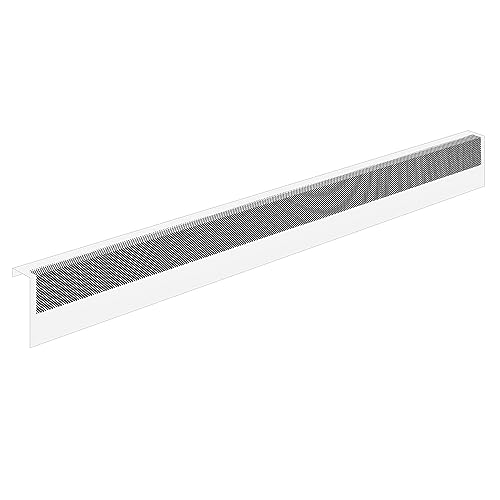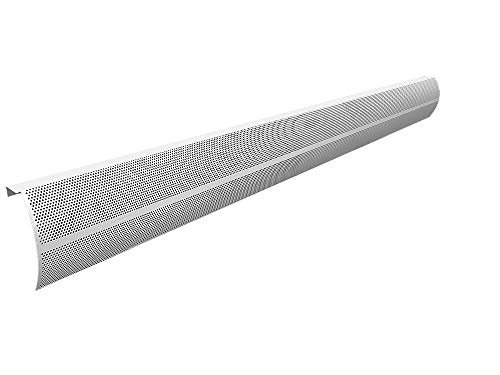The guide below highlights the most relevant 72 inch baseboard heaters and 6 ft replacement covers for hydronic and electric systems. Each pick includes core features, suitability notes, and installation considerations to help you compare options and select the right product for your space.
| Product | Type | Primary Feature |
|---|---|---|
| Cadet F Series 72 in. Electric Baseboard Heater | Electric Heater | 120V, 1500W continuous heat |
| Baseboarders Basic Series 6 ft Slip-On Cover | Hydronic Cover | Galvanized steel, lifetime rust protection |
| SDSNTE 6ft Steel Slip-On Cover With End Caps | Hydronic Cover | 21-gauge steel, single-panel airflow |
| Caoooort 3FT-6FT Retractable Baseboard Cover | Adjustable Hydronic Cover | Telescoping design, includes end caps |
| Baseboarders Elliptus Series 6 ft Slip-On Cover | Hydronic Cover | Elliptus profile, lifetime rust warranty |
Content Navigation
- Cadet F Series 72 in. Electric Baseboard Heater
- Baseboarders Basic Series 6 ft Slip-On Cover
- SDSNTE 6ft Steel Slip-On Baseboard Heater Cover
- Caoooort 3FT-6FT Retractable Baseboard Cover
- Baseboarders Elliptus Series 6 ft Slip-On Cover
- Buying Guide: How To Choose A 72 Inch Baseboard Heater Or Cover
- 1. Identify System Type: Hydronic vs Electric
- 2. Material And Corrosion Resistance
- 3. Heat Output And Voltage (Heaters Only)
- 4. Safety Features And Surface Temperatures
- 5. Fit And Dimensions
- 6. Installation And Mounting Style
- 7. Aesthetics And Room Conditions
- 8. Warranty And Manufacturer Guidance
- 9. Comparing Perspectives: Performance vs. Appearance
- 10. Professional vs DIY Considerations
Cadet F Series 72 in. Electric Baseboard Heater

This Cadet model is a full-length 72-inch electric baseboard heater designed for continuous convection heating. It operates on 120 volts at 1500 watts, suitable for medium-sized rooms where hardwired electric baseboard heat is the chosen method.
- Heating Method: Continuous convection heat distribution along the element.
- Construction: All-metal housing with powder-coated finish for durability.
- Safety: Standard high-temperature protection typical of Cadet F Series units.
- Installation: Requires proper circuit wiring and mounting; compatible with wall- or floor-mount as typical for electric baseboards.
Best suited where a mains-powered, hardwired baseboard solution is needed. Note that electric units reach higher surface temperatures than hydronic systems; choose covers or placement accordingly.
Baseboarders Basic Series 6 ft Slip-On Cover

The Baseboarders Basic Series is a 6 ft (72 inch) galvanized steel cover intended for hydronic (water) baseboard systems. It’s a slip-on replacement cover designed to restore aesthetics and resist rust.
Call 888-896-7031 for Free Local HVAC Quotes – Compare and Save Today!
- Material: Galvanized steel with white finish and lifetime protection against rust for normal use.
- Compatibility: Specifically designed for hydronic systems; manufacturer warns against use on electric baseboards.
- Design: Simple, low-profile look with available accessories and optional attachments to customize appearance.
- Installation: Slip-on style allows DIY replacement of old, corroded covers.
Choose this cover when replacing rusty hydronic covers and prioritizing corrosion resistance and ease of installation. Do not use on electric baseboard heaters due to higher surface temperatures.
SDSNTE 6ft Steel Slip-On Baseboard Heater Cover

The SDSNTE cover is built for durability and safety. Constructed from 21-gauge steel with 16-gauge end caps, this 6 ft cover emphasizes stronger construction and maintained airflow for efficient heat dispersion.
- Durability: Thick steel construction and white stoving varnish for rust resistance.
- Safety: Single-panel design reduces direct contact with heating elements, improving safety for children and pets.
- Fit Guidelines: Designed for baseboard lengths under 6 ft, heights under 8.5 inches, and widths under 3.25 inches.
- Installation: Slip-on replacement, marketed for DIY home improvement projects.
Good option when a robust, rust-resistant cover is required for a hydronic system, with attention to fit dimensions before purchase.
Caoooort 3FT-6FT Retractable Baseboard Cover

The Caoooort cover is an adjustable telescoping design that ships as two 3 ft sections which combine to cover up to 6 ft. It’s aimed at users who want flexibility and included end caps in one package.
Call 888-896-7031 for Free Local HVAC Quotes – Compare and Save Today!
- Adjustability: Sections connect and adjust to fit lengths from 3 ft up to 6 ft for adaptable installations.
- Material: Galvanized steel with white powder-coated finish for rust resistance and heat tolerance.
- Kit Contents: Includes two 3 ft covers, mounting kit, and left/right end covers to simplify installation.
- Compatibility: Targeted for hydronic covers; check compatibility with electric baseboards due to surface temperature differences.
Ideal when you want a modular solution or need to cover nonstandard lengths without cutting or custom ordering. Verify your heater profile before installing.
Baseboarders Elliptus Series 6 ft Slip-On Cover

The Elliptus Series provides a refined profile and a lifetime rust warranty, marketed as especially suitable for humid rooms like bathrooms. It’s slip-on and compatible with hydronic systems; manufacturer notes potential use on electric units with caution.
- Design: Elliptus curved profile intended for improved aesthetic in visible locations like bathrooms.
- Warranty: Lifetime guarantee against rust for normal use, emphasizing long-term durability.
- Application: Primarily for hydronic systems; optional end caps add to overall length and finish.
- Installation: Slip-on style for straightforward replacement of old covers.
Choose Elliptus where visual design and corrosion protection are priorities, particularly in humid environments. Confirm safe use when paired with electric heaters.
Buying Guide: How To Choose A 72 Inch Baseboard Heater Or Cover
This buying guide outlines the critical considerations when selecting a 72 inch baseboard heater or a replacement 6 ft cover. Compare heat source, material, safety, compatibility, and installation to match product to your system and room.
1. Identify System Type: Hydronic vs Electric
Hydronic (water) baseboards circulate warm water and generally run cooler at the cover surface; most slip-on covers are designed for hydronic systems. Electric baseboards operate at higher surface temperatures; many hydronic covers are not rated for electric use. Verify manufacturer guidance before combining covers with electric units.
2. Material And Corrosion Resistance
Look for galvanized steel or powder-coated steel for rust resistance, especially in bathrooms or humid basements. Thicker gauges (e.g., 21-gauge) and heavier end caps increase durability and longevity.
3. Heat Output And Voltage (Heaters Only)
For electric heaters, confirm voltage and wattage ratings (120V vs 240V, wattage range) and match your circuit capacity. Wattage determines heat output; 1500W at 120V is common for medium rooms. Consult an electrician for proper wiring and breaker sizing.
4. Safety Features And Surface Temperatures
Electric baseboards can reach high surface temperatures. If choosing covers for electric units, ensure the cover is rated for higher temperatures. For homes with children or pets, consider single-panel designs or covers that limit direct contact with heating elements.
5. Fit And Dimensions
Measure the length, height, and depth of existing baseboard units before purchasing a cover. Common limits: length under 6 ft, height under ~8.5 inches, and width limits around 3¼ inches. Adjustable or telescoping covers offer flexibility but still require height/depth verification.
6. Installation And Mounting Style
Slip-on covers are typically DIY-friendly. Confirm whether end caps and mounting hardware are included. For electric heater replacement, electrical work may require a licensed electrician. For hydronic covers, slip-on installation usually involves removing old rusted covers and sliding the new cover into place.
7. Aesthetics And Room Conditions
Profile shapes (elliptus, basic) and finishes affect room appearance. In humid rooms, prioritize corrosion-resistant finishes and warranties. Choose profiles that match baseboard depth so the cover does not obstruct airflow or trim.
8. Warranty And Manufacturer Guidance
Check for lifetime rust warranties or manufacturer guidance about suitable use with electric heaters. Warranty terms and recommended use-cases help avoid mismatched applications that could reduce safety or lifespan.
9. Comparing Perspectives: Performance vs. Appearance
When selecting between a full electric heater and a slip-on cover, balance performance needs (actual heat output) with appearance and safety. Electric heaters supply heat; covers improve aesthetics and can protect components for hydronic systems. For electric systems, compatibility and safety are paramount.
10. Professional vs DIY Considerations
Replacing a cover is often a DIY job for hydronic systems if fit is correct. Installing or replacing electric baseboard heaters typically involves electrical work; consult a qualified electrician for wiring changes or new installations to ensure code compliance and safety.
Tips for Getting the Best HVAC Prices
- Prioritize Quality Over Cost
The most critical factor in any HVAC project is the quality of the installation. Don’t compromise on contractor expertise just to save money. - Check for Rebates
Always research current rebates and incentives — they can significantly reduce your overall cost. - Compare Multiple Quotes
Request at least three estimates before making your choice. You can click here to get three free quotes from local professionals. These quotes include available rebates and tax credits and automatically exclude unqualified contractors. - Negotiate Smartly
Once you've chosen a contractor, use the proven strategies from our guide — How Homeowners Can Negotiate with HVAC Dealers — to get the best possible final price.
